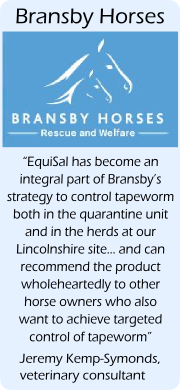Home The Horse Tapeworm The Tapeworm Lifecycle
The Tapeworm Lifecycle
 The life cycle of A. perfoliata requires an intermediate host. Infected horses pass tapeworm eggs onto the pasture where they are consumed by free-living oribatid mites. The eggs develop into larvae within the mite until the mite is ingested by a grazing horse, allowing the larvae to be released into intestine. The larvae complete their life cycle by attaching to the lining of the intestines where they develop into adult tapeworms capable of releasing eggs.
The life cycle of A. perfoliata requires an intermediate host. Infected horses pass tapeworm eggs onto the pasture where they are consumed by free-living oribatid mites. The eggs develop into larvae within the mite until the mite is ingested by a grazing horse, allowing the larvae to be released into intestine. The larvae complete their life cycle by attaching to the lining of the intestines where they develop into adult tapeworms capable of releasing eggs.
The body of an adult tapeworm (termed the strobila) is composed of a chain of increasingly mature segments (called proglottids). Each segment is self-sufficient and complete with male and female reproductive organs which develop at different rates. New segments are constantly being produced behind the head (scolex) and they develop progressively as they are pushed towards the posterior end. Mature segments are gravid (full of fertilised eggs) and ready to detach from the body of the tapeworm and pass within the faeces into the environment, whereupon they can be eaten by oribatid mites and the cycle begins again.


